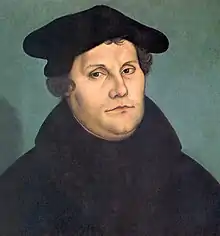Gelobet seist du, Jesu Christ, BWV 91
Gelobet seist du, Jesu Christ (Praise be to You, Jesus Christ),[1] BWV 91, is a church cantata by Johann Sebastian Bach. He wrote the Christmas cantata in Leipzig in 1724 for Christmas Day and first performed it on 25 December 1724. The chorale cantata is based on the hymn "Gelobet seist du, Jesu Christ" (1524) by Martin Luther.
| Gelobet seist du, Jesu Christ | |
|---|---|
BWV 91 | |
| by J. S. Bach | |
 Martin Luther, author of the hymn, in 1533 by Lucas Cranach the Elder | |
| Chorale | |
| Performed | 25 December 1724: Leipzig |
| Movements | 6 |
| Vocal | SATB choir and solo |
| Instrumental |
|
History and words
The chorale cantata from Bach's second annual cycle is based on the main chorale for Christmas Day, "Gelobet seist du, Jesu Christ" (1524) by Martin Luther. The beginning summarizes Christmas in two lines: "Gelobet seist du, Jesu Christ, daß du Mensch geboren bist" (Praise be to You, Jesus Christ, since You were born a man).[1] All stanzas end with the acclamation Kyrieleis. The cantata was Bach's first composed for Christmas Day in Leipzig; in his first year in Leipzig 1723 he had chosen to perform again Christen, ätzet diesen Tag, BWV 63, written before in Weimar.[2]
The prescribed readings for the feast day were from the Epistle to Titus, "God's mercy appeared" (Titus 2:11–14) or from Isaiah, "Unto us a child is born" (Isaiah 9:2–7), and from the Gospel of Luke, the Nativity, Annunciation to the shepherds and the angels' song (Luke 2:1–14). The unknown poet of the cantata text kept the first and the last stanza, expanded verse 2 by recitatives, transformed stanzas 3 and 4 to movement 3, an aria, stanza 5 to a recitative, and stanza 6 again to an aria.[3]
Bach performed the cantata again four more times on 25 December, in 1731, in 1732 or 1733, and twice in the 1740s, even after his Christmas Oratorio had been first performed in 1734, which also uses two stanzas of Luther's chorale.
Scoring and structure
The cantata in six movements is festively scored for soprano, alto, tenor, and bass, a four-part choir, two horns, timpani, three oboes, two violins, viola and basso continuo.[3] He would later use the pair of horns in Part IV of his Christmas Oratorio.
- Chorale: Gelobet seist du, Jesu Christ
- Recitative (and chorale, soprano): Der Glanz der höchsten Herrlichkeit
- Aria (tenor): Gott, dem der Erden Kreis zu klein
- Recitative (bass): O Christenheit! Wohlan
- Aria (soprano, alto): Die Armut, so Gott auf sich nimmt
- Chorale: Das hat er alles uns getan
Music
The opening chorus makes use of four choirs: the voices, the horns, the oboes and the strings. The material from the ritornellos is present also in interludes between the five lines and as accompaniment for the vocal parts. The choral melody is sung by the soprano. The lower voices are set in imitation for the first and the last line, in chords for the second and fourth line, and in a combination in the central line "Von einer Jungfrau, das ist wahr" (from a virgin, this is true).[1]
In movement 2, the recitative is contrasted with chorale phrases, which are accompanied by a repetition of the first line of the chorale in double tempo. The tenor aria is accompanied by three oboes, whereas the strings illuminate the following recitative. The last aria is a duet, contrasting "Armut" (poverty) and "Überfluss" (abundance), "Menschlich Wesen" (human being), rendered in chromatic upward lines, and "Engelsherrlichkeiten" (angelic splendours),[1] shown in coloraturas and triadic melodies.
At times the horns have independent parts in the closing chorale and embellish especially the final Kyrieleis.[3][4]
Recordings
- J. S. Bach: Das Kantatenwerk – Sacred Cantatas Vol. 5, Gustav Leonhardt, Knabenchor Hannover, Collegium Vocale Gent, Leonhardt-Consort, Detlef Bratschke (soloist of the Knabenchor Hannover), Paul Esswood, Kurt Equiluz, Max van Egmond, Teldec 1979
- J. S. Bach: Complete Cantatas Vol. 12, Ton Koopman, Amsterdam Baroque Orchestra & Choir, Lisa Larsson, Annette Markert, Christoph Prégardien, Klaus Mertens, Antoine Marchand 2000
- Bach Cantatas Vol. 14: New York, John Eliot Gardiner, Monteverdi Choir, English Baroque Soloists, Katharine Fuge, Robin Tyson, James Gilchrist, Peter Harvey, Soli Deo Gloria 2000
- J. S. Bach: Christmas Cantatas from Leipzig, Philippe Herreweghe, Collegium Vocale Gent, Dorothee Mields, Ingeborg Danz, Mark Padmore, Peter Kooy, Harmonia Mundi Franc 2001
- J. S. Bach: Cantatas Vol. 31, conductor Masaaki Suzuki, Bach Collegium Japan, Yukari Nonoshita, Robin Blaze, Gerd Türk, Peter Kooy, BIS 2004
References
| German Wikisource has original text related to this article: |
- Dellal, Pamela. "BWV 91 – Gelobet seist du, Jesu Christ". Emmanuel Music. Retrieved 20 December 2014.
- Mincham, Julian (2010). "Chapter 28 BWV 91 Gelobet seist du, Jesu Christ / We praise you, Jesus Christ". jsbachcantatas.com. Retrieved 12 December 2010.
- Dürr, Alfred (1981). Die Kantaten von Johann Sebastian Bach (in German). 1 (4 ed.). Deutscher Taschenbuchverlag. pp. 109–111. ISBN 3-423-04080-7.
- Gardiner, John Eliot (2005). Johann Sebastian Bach (1685-1750) / Cantatas Nos 40, 91, 110 & 121 (Media notes). Soli Deo Gloria (at Hyperion Records website). Retrieved 31 December 2018.
Sources
- Gelobet seist du, Jesu Christ, BWV 91: Scores at the International Music Score Library Project
- Gelobet seist du, Jesu Christ BWV 91; BC A 9b / Chorale cantata (1st Christmas Day) Leipzig University
- Cantata BWV 91 Gelobet seist du, Jesu Christ history, scoring, sources for text and music, translations to various languages, discography, discussion, Bach Cantatas Website
- BWV 91 Gelobet seist du, Jesu Christ English translation, University of Vermont
- BWV 91 Gelobet seist du, Jesu Christ text, scoring, University of Alberta
- Luke Dahn: BWV 91.6 bach-chorales.com